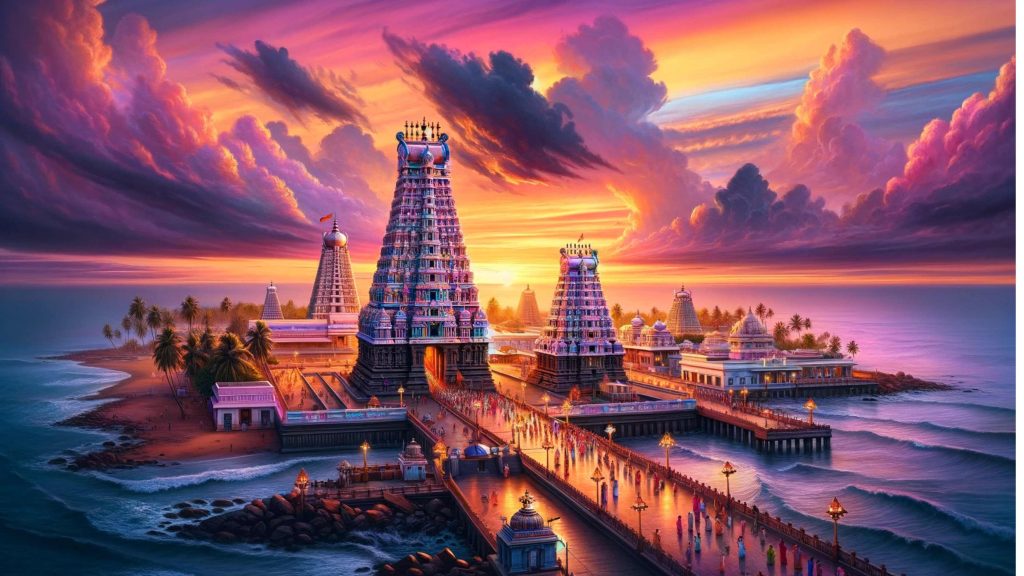Best Time to Visit Tiruchendur Temple – A Travel Guide

Introduction
Greetings, fellow travelers and culture enthusiasts! Today, we’re embarking on a virtual journey to one of India’s most enchanting and spiritually charged locales – the Tiruchendur Temple. Nestled along the shores of Tamil Nadu, this temple isn’t just a testament to architectural grandeur; it’s a portal to a rich, cultural tapestry that’s as vibrant as India itself. And let’s be honest, who wouldn’t be intrigued by a temple that’s a stone’s throw from the ocean, offering both spiritual solace and natural beauty? Our mission? To uncover the best times to visit this sacred site, ensuring your journey is as mesmerizing as the destination itself.
The Historical and Cultural Significance of Tiruchendur Temple
- A Dive into the Past: The Tiruchendur Temple’s story is steeped in legend and lore. Dedicated to Lord Murugan, a revered deity in Hindu mythology, the temple is more than just a structure; it’s a living narrative of divine intervention and earthly devotion. I remember reading ‘Pilgrimage to Temple Heritage’ by Brinda Sarathy, which vividly describes how this temple survived the wrath of the Dutch invasion in the 17th century – talk about resilience!
- Architectural Marvel: The temple’s Dravidian architecture is a visual feast. Its gopuram (tower) doesn’t just reach for the skies; it narrates stories with intricate carvings of gods, goddesses, and mythical creatures. It’s a testament to the craftsmen’s skill and a window into a bygone era.
- Rituals and Practices: Here’s where it gets interesting. The temple’s rituals are not just routines; they are theatrical performances of devotion. The ‘Kanda Sashti’ festival, for instance, is a six-day spectacle of colors, music, and dance, celebrating the victory of good over evil.
The Best Times to Visit
Now, let’s talk strategy. When should you pack your bags to experience Tiruchendur at its finest?
- Weather-wise: In my experience, November to March is the sweet spot. The weather is pleasant – not too hot, not too humid. It’s perfect for exploring without turning into a human puddle of sweat. Trust me on this!
- Crowd Control: If you’re like me and prefer avoiding the tourist rush, aim for the shoulder months like February or March. You get the good weather without the elbow-to-elbow hustle.
- Seasonal Splendor:
- Monsoon Magic (July to September): Some may say it’s a gamble with the rains, but it’s also when the temple and its surroundings are in full bloom, emerald green and vibrant. It’s nature’s makeover at its best.
- Winter Wonder (November to February): This is peak pilgrimage season, coinciding with several festivals. Yes, it’s crowded, but it’s also when the temple’s cultural heartbeat is loudest.
Remember, choosing the right time to visit isn’t just about comfort; it’s about connecting with the place in its most authentic form. So, dear readers, when are you planning your trip? Are you a monsoon adventurer or a winter wanderer? Drop your thoughts in the comments; I’m eager to hear your preferences and experiences! Let’s make this a lively discussion.
Festivals and Special Occasions
- The Skanda Sashti Festival: If you’re planning a trip, align it with Skanda Sashti. Trust me, it’s a cultural extravaganza you don’t want to miss. Over six days, the temple reenacts the battle between Lord Murugan and the demon Soorapadman. The final day, known as Soorasamharam, is an absolute visual spectacle. I still get goosebumps thinking about the vibrant processions and the palpable energy in the air!
- Panguni Uttiram: Occurring in March-April, this festival celebrates the celestial wedding of Lord Murugan. It’s like attending a divine marriage, and the festivities are just out of this world (literally and figuratively).
- Practical Tip: Accommodations fill up fast during these festivals. Book well in advance, and brace yourself for a sea of humanity. But remember, being part of this crowd is part of the charm!
Travel Tips for International Visitors
- Visa and Travel: Most U.S. citizens need a visa for India. Opt for an e-Visa for convenience. Flights to Madurai or Tuticorin, followed by a scenic drive, is your best bet to reach Tiruchendur.
- Stay Options: From cozy guesthouses to upscale hotels, there’s something for every budget. I recommend staying near the temple for the full experience.
- Local Customs: Brush up on basic Tamil phrases – it goes a long way in showing respect for the local culture. Also, dress modestly when visiting the temple – it’s a sign of respect.
- Money Matters: While major hotels and shops accept cards, cash is king in smaller establishments. Keep some Indian Rupees handy for those quaint local shops.
Experiencing Local Culture and Cuisine
- Beyond the Temple: Take a day to explore the local villages. The intricate palm leaf handicrafts are a must-see. And if time permits, the nearby Thoothukudi city, with its colonial history and unique architecture, is worth a visit.
- Culinary Delights: Don’t leave without trying the local cuisine. The seafood here is as fresh as it gets, and the variety of spicy Tamil dishes will tantalize your taste buds.
Conclusion
So there you have it, folks – your guide to making the most of your visit to Tiruchendur Temple. Whether you’re there for spiritual reasons, cultural curiosity, or just to satiate your wanderlust, this place will leave you with memories to cherish for a lifetime. I can’t wait to hear about your experiences, so please, share your stories in the comments. Let’s keep the conversation going and build a community of globe-trotting enthusiasts!



0 Comments